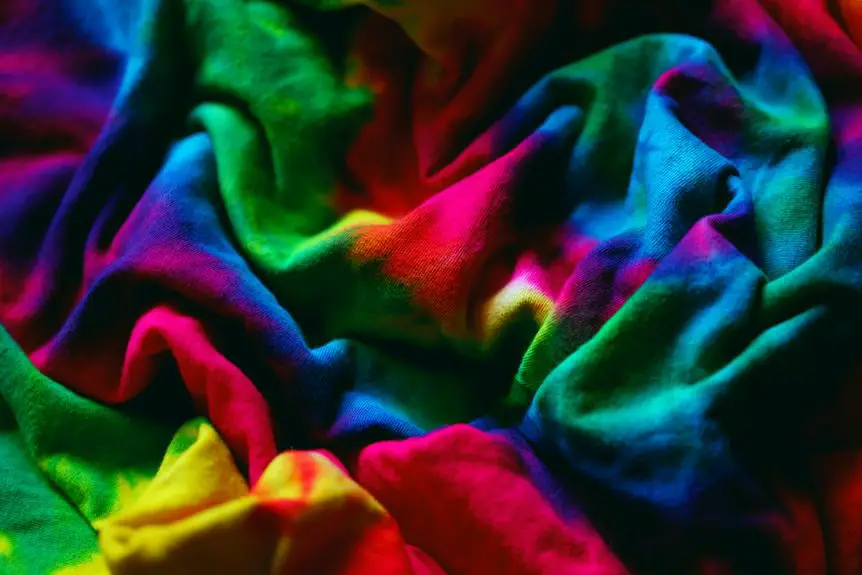You can avoid brown in your tie-dye by using vibrant primary colors like red, yellow, and blue, applying each in distinct sections. Analogous colors next to each other on the wheel create smooth blends without muddiness. Bold contrasts, like hot pink with lime green, keep colors popping without turning dull. Apply lighter dyes first and let them set before layering darker shades to prevent bleeding. Keep going, and you’ll discover even more tips for perfect, vibrant tie-dye results.
Key Takeaways
- Use primary colors (red, yellow, blue) in distinct sections to avoid muddy brown mixing.
- Combine analogous colors (e.g., blue, green, teal) for smooth blending without dullness.
- Pair bold contrasting colors (like hot pink and lime green) to maintain vibrant clarity.
- Apply lighter dyes first and let them set before adding darker shades to prevent bleeding.
- Use high-quality dyes and precise application to ensure bright, crisp colors without browning.
Understanding Why Tie-Dye Colors Turn Brown
Although tie-dyeing seems simple, you might notice your colors turning brown instead of vibrant hues. This usually happens because certain color combinations mix to create muddy shades. When you combine too many colors or mix complementary colors—like red and green—they often blend into brown.
Another reason is using too much dye or overlapping colors excessively, which causes the pigments to combine in unwanted ways. Also, the type of dye and fabric you choose affects the outcome; poor-quality dyes or synthetic fabrics may not hold colors well, leading to dull, brownish tones.
To avoid this, you need to understand how colors interact and control the amount of dye applied. Mastering these basics helps you keep your tie-dye bright and fresh.
Vibrant Primary Color Pairings That Stay Bright
Vibrant primary color pairings, like red and yellow or blue and red, keep your tie-dye projects bold and eye-catching.
When you stick to primary colors, you avoid the muddy browns that often come from mixing too many hues.
Here’s how to maximize brightness while using these dynamic combos:
- Use pure red, yellow, and blue dyes without blending them beforehand.
- Apply colors in distinct sections to maintain clarity and prevent unwanted color mixing.
- Choose high-quality dyes for vibrant saturation and lasting color.
- Let each color set before adding the next to avoid bleeding and dullness.
Using Analogous Colors for Smooth Blending
While primary colors keep your tie-dye bold and distinct, using analogous colors lets you create smooth blends that flow naturally from one shade to the next.
Choose colors sitting next to each other on the color wheel—like blue, teal, and green—to achieve gentle shifts without muddying your design. This approach guarantees each hue complements the others, producing a harmonious look that feels cohesive.
When applying dye, overlap these shades slightly so they merge subtly, avoiding harsh lines. Analogous color schemes work great for creating calming, nature-inspired patterns or soft gradients.
Bold Contrasts That Prevent Muddy Mixing
If you want your tie-dye to pop without turning into a muddy mess, choosing bold contrasting colors is key.
These contrasts create clear boundaries between hues, preventing them from blending into brownish tones. To nail this, consider these combinations:
- Bright red and deep turquoise – the warm and cool contrast keeps colors vibrant.
- Royal blue and sunny yellow – strong primary colors that stay distinct.
- Hot pink and lime green – neon shades that clash beautifully without dulling.
- Purple and orange – both rich but opposite on the color wheel, avoiding muddiness.
Tips for Applying and Layering Dyes Correctly
Because applying and layering dyes correctly can make or break your tie-dye project, you need to be deliberate with your technique.
Start by applying lighter colors first since they won’t overpower darker dyes. When layering, give each color enough time to absorb before adding the next to avoid muddying. Use squirt bottles to control dye placement precisely, preventing unwanted blending.
Remember to wring excess water from your fabric before dyeing; too much moisture causes colors to bleed together. If you want sharp contrasts, keep your sections well-separated with tight folds or rubber bands.
Finally, always wear gloves and work on a protected surface to keep your design clean. By following these steps, you’ll achieve vibrant, clear patterns without dull or brown patches.
Frequently Asked Questions
Can Natural Dyes Be Used Effectively for Tie-Dye Without Browning?
You might think natural dyes always brown when mixed, but you can use them effectively in tie-dye by carefully layering colors and avoiding certain combinations. You’ll get vibrant results without that unwanted muddy look.
How Does Fabric Type Affect Tie-Dye Color Outcomes?
You’ll find that fabric type greatly affects tie-dye colors; natural fibers like cotton absorb dye better, producing vibrant hues, while synthetics may result in duller colors or uneven patterns. Choose fabrics accordingly for best results.
What Is the Best Way to Fix Colors to Prevent Fading?
To fix colors and prevent fading, you should soak your fabric in a soda ash solution before dyeing. After dyeing, rinse with cold water, then wash in cold, gentle detergent to lock in vibrant colors longer.
Are There Eco-Friendly Alternatives to Traditional Tie-Dye Dyes?
You can definitely choose eco-friendly tie-dye options like natural plant-based dyes or fiber-reactive dyes, which use fewer chemicals. These alternatives help reduce environmental impact and still give you vibrant, lasting colors you’ll love.
How Long Should Tie-Dye Projects Be Left to Set Before Washing?
You should let your tie-dye project set for at least 6 to 8 hours, but ideally overnight. This gives the dye time to bond with the fabric, ensuring vibrant, long-lasting colors before you wash it.

